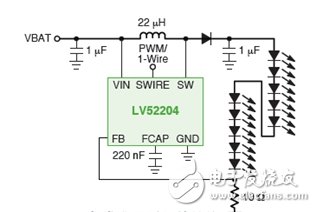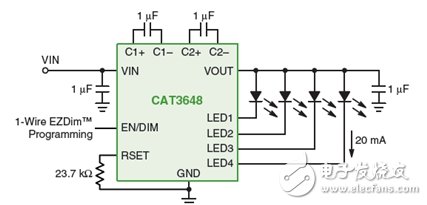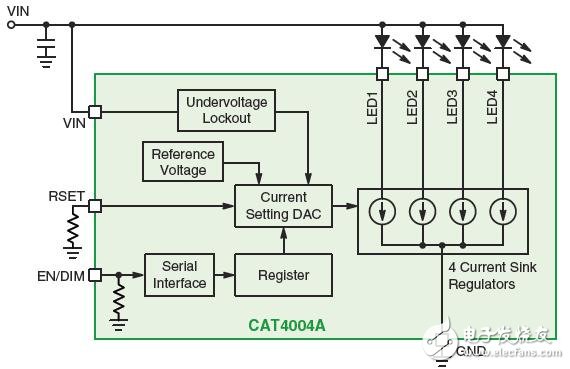Light-emitting diode (LED) light output continues to increase, and color and white high-brightness LED applications have expanded to new market segments. LEDs have begun to replace incandescent and fluorescent lamps for automotive, consumer electronics, building lighting and general lighting applications, from smartphones to LCD TVs. In the future, LEDs will continue to change the lighting market with its programmability and flexibility and innovative solid-state lighting (SSL) solutions.
LEDs are low voltage devices that can be driven between 2V and 4.5V depending on color and current, and are driven at a constant current to ensure the required light intensity and color. This requires a power conversion and control scheme to connect different power sources, even batteries. ON Semiconductor offers optimized drive solutions for low-voltage portable and medium voltage LED general illumination to meet the lighting needs of different applications.
Low-voltage portable LED driver topology and ON Semiconductor solutions
White LEDs and RGB tri-color LEDs are widely used for small color LCD panels, keyboards and indicator backlights. Smartphones and digital cameras use high-brightness LEDs as flash sources. These applications require long battery life and minimize PCB area and height. ON Semiconductor offers a variety of solutions using linear, inductive and charge pump topologies. The inductive solution has the best overall energy efficiency; the charge pump solution uses low-profile ceramic capacitors with minimal space and height; the linear solution is ideal for color indicators and simple backlighting applications.
1) Inductive boost and buck topology
For white LEDs that drive low-voltage portable device backlights and flashlight/flash applications, ON Semiconductor offers different products that use PWM dimming. The booster's output current ranges from 20 mA to 800 mA, including CAT37, CAT32, CAT4238, CAT4237, CAT4238, LV52204, LV52206, CAT4137, NCP5005, CAT4139, CAT4240, and NCP1422. The output current of the inductor step-down product NCP1529 is 1 A.

Figure 1: Inductive Boost Topology
For example, the LV52204 is a single-channel high-voltage and energy-efficient LED backlight boost driver IC for smartphones with an input voltage range of 2.7 V to 5.5 V, 40 V output voltage and 10 LEDs. Its pins are compatible with popular products on the market and can be easily replaced.
2) Charge pump topology
ON Semiconductor's patented Quad-Mode® adaptive fractional charge pump solution provides the energy-efficient level of inductive LED drivers, eliminating high-thickness inductors and harmful electromagnetic interference (EMI). The four-mode architecture adds a fourth mode of operation (1.33x), requiring no additional capacitors, a 10% increase in energy efficiency and a 65% reduction in package size.

Figure 2: Charge Pump Topology
For LCD backlights, LED flash/flashlights and indicators, ON Semiconductor offers a wide range of charge pump/white and RGB LED driver products with total output currents from 10 to 192 mA, including NCP1840, CAT3606, CAT3616, CAT3626, CAT3636, AT3637, CAT3649 , CAT3604A, CAT3604V, CAT3614, CAT3644, NCP5623B/C, CAT3643, CAT3647, CAT3612, CAT3224 (4 flash, 400 mA flashlight), NCP5612, CAT3661, NCP5603 (200 mA DC, 350 mA pulse), CAT3200, CAT3200H.
3) Linear topology scheme
For LCD backlight applications in portable devices such as mobile phones, ON Semiconductor offers a variety of simple linear white LED drivers. It features single-line EZDim interface dimming with 32 levels of dimming control; 25 mA fixed current (version B) or adjustable current (A version). These single-mode LED drivers can be used as part of the system level to design backlight circuits that integrate low-voltage LEDs with simple LED drivers.

Figure 3: Linear topology
4) Other dedicated drives
ON Semiconductor offers dedicated LED drivers for applications such as camera flash and flashlights, such as CAT3224 and CAT3612 (charge pump topology), CAT4134 (inductive boost topology), which can provide different flash currents and brightness from 150 mA to 4A. Meet the ever-increasing demand for LED light output instead of camera phones, smartphones and xenon lamps.
ON Semiconductor also offers a variety of drive solutions for RGB LEDs, such as multi-channel multifunction LED drivers with independent RGB on/off (LV5207LP and LV5216CS), flash/electric cylinders for 7 to 16 LED channels, RGB illumination, Applications such as main LCD backlight, auxiliary LCD backlight, and RGB lighting drivers (LV5217LP and LV5223GR) are used to support color lighting design to achieve rich lighting colors for portable devices.
What is 5G CPE?
5G CPE is a kind of 5G terminal equipment. It takes 5G signals from a carrier's base station and converts them into WiFi or wired signals, allowing more local devices (phones, tablets, computers) to access the Internet. It can be seen that 5G CPE is similar to the function of the "optical network unit" for home fiber broadband access.
What is a WiFi router?
WiFi routers are also known as wireless routers or access points.
A WiFi router acts as a Wi-Fi transmitter. It connects directly to a modem, router or switch via cable. This allows it to receive information from the Internet and transmit information to the Internet. Phones, tablets, laptops and other devices can pick up its Wi-Fi signal and then connect to the Internet.
What is the difference between 5G CPE and WiFi router?
The 5G CPE is actually a combination of a 5G modem and a WiFi router. With an independent 5G CPE, the device can access the Internet directly through the WiFi signal or the LAN port of the CPE. Of course, the 5G SIM card needs to be inserted into the SIM card slot of the CPE. However, a WiFi router will not be able to provide Internet access without connecting to a modem or router via cable.
To provide users with greater flexibility and reliability, many 5G CPE routers not only support 5G networks and 4G LTE networks, but also come equipped with WAN Ethernet ports for surfing the Internet. For local networks, WiFi 6, WiFi 5, and LAN ports are usually supported. Some models, such as the Hocell 5G CPE M111, are also equipped with telephone ports for VoLTE/ VoNR voice services.
What are the advantages of 5G CPE over ONU?
ONU is a kind of CPE, and the difference between ONU and 5G CPE is that the former connects to optical fiber access network equipment, while 5G CPE connects to 5G base stations.
There is also a question, since there is an ONU, why do you still need 5G CPE, and will 5G CPE replace ONU?
Let's start with the conclusion, of course not.
The current 5G CPE products all use the same or similar 5G chips as 5G mobile phones, have strong 5G connectivity, support SA/NSA networking, and are compatible with 4G/5G signals. In terms of speed, 5G CPE is similar to ONU.
The advantages of 5G CPE
1. Mobility and
Unlike traditional ONUs, which can only be used in fixed locations, 5G CPE can be "mobile." Where there is a 5G signal, 5G CPE can be used.
For example, when we go on a family vacation to a suburban estate, we can use 5G CPE to set up a Wi-Fi 6 high-speed hotspot that allows all family members to go online and share videos on social networks.
Another example is when a company is away at a trade show, it can use 5G CPE to provide Internet access to visitors and employees.
Traditional "fibre broadband" is relatively easy to set up. You go to the sales office and request a package, and then you can open it. But cancelling is tricky. Today's broadband services have a contract period. Before the end of the agreement period, you can not arbitrarily stop it. If you need to move, you have to switch to fiber broadband, which is also very troublesome. As for 5G CPE, as long as you have a 5G mobile phone SIM card, you can get high-speed Internet access.
For young people who are renting, as well as small businesses that need Internet service, 5G CPE is an ideal choice because of its mobility, fast Internet service registration and termination. 5G CPE is also suitable for remote areas or places with difficult terrain where fiber is virtually unavailable. Due to its large area and small population, many parts of the world began to use CPE long ago. They use 5G Outdoor CPE to receive signals from base stations and convert them into raw signals to access the Internet.
5G CPE can be upgraded to small base stations
5G CPE modifies 4G or 5G as a WiFi hotspot. WIFI devices can be converted via 5G CPE to access 4G or 5G networks.
Further, the WIFI hotspot, including the information processing and transmission within the CPE, is divided into 2 completely separate channels. The internal network channel has its own wi-fi, which is supervised by a person, and also has an account password verification. The external network channel is regulated and managed by the carrier. Two-way verification, remote monitoring, encrypted transmission, vibrant passwords, strict isolation of software and some devices to meet carrier-grade security requirements, complete isolation of indoor and outdoor wi-fi, extrannetwork-channel authentication of customer SIM cards,
5G CPE can be upgraded to a small base station, with both WiFi LAN and micro-base station functions. Good signal at the window, negative signal inside the car. Install a 5G CPE micro-base station by the window of your home and connect it to a power supply (or bring your own power supply).
It can access 4G and 5G networks through the CPE's external network. The phone charges, SMS charges, and information charges generated by the CPE are included in the phone SIM card number, but are not included in the CPE device. Peripheral WIFI devices without SIM cards, computer tablets (generally with WIFI), without wi-fi can get the USB user interface wi-fi card, through the WIFI Intranet access to 4G/5G network, resulting in traffic charges Input number corresponding to the CPE SIM card.
5G CPE micro base station, no matter where you go, as long as there is a 4G/5G signal by the window, there are mobile phones indoors, there are other terminal tools with SIM cards, and WIFI, you can call the Internet standby to solve the problem of indoor invisible. WIFI tools without SIM cards can also pass through the Intranet.
5G CPE applications
1. 5G CPE will act as a smart home gateway
In addition to providing Internet access, 5G CPE will also act as a smart home gateway in the future.
The demand for home routers has been the focus of competition among many vendors, because the router itself brings profits, as it is the gateway to the entire home network service and the entry platform for digital home operations. The 5G CPE serves the same purpose as a router. It will be the intelligent gateway for the unborn 5G family and the fulcrum for the intelligent life of the whole family.
With 5G CPE, users can control a variety of smart devices in their homes and connect everything, significantly enhancing the life experience of family members.
5G CPE has great potential for enterprise demand
In addition to consumer demand, 5G CPE has a very broad operational prospect in terms of enterprise demand.
Take smart factories, for example. In the future, all the devices and gears in the factory will be networked. 5G CPE can act as a unified traffic inlet and outlet for all devices in an area (shop floor), providing low-cost, high-speed network connectivity for these devices.
With the increase of application scenarios, 5G CPE will support more communication protocols other than 5G (such as Bluetooth, UWB, etc.), and truly become the control center of all devices.
3. Pipe network monitoring
Urban heating monitoring, natural gas network wireless monitoring, urban water supply network monitoring.
conclusion
All in all, 5G CPE is very important for both households and businesses.
With the full rollout of 5G network construction, 5G signal coverage is getting farther and farther. The demand for 5G CPE will continue to increase, and there will be more and more application scenarios around 5G CPE.
5G Cpe,Wifi 6 Router,5G Wifi Router,5G Sim Card Router
Shenzhen MovingComm Technology Co., Ltd. , https://www.movingcommtech.com